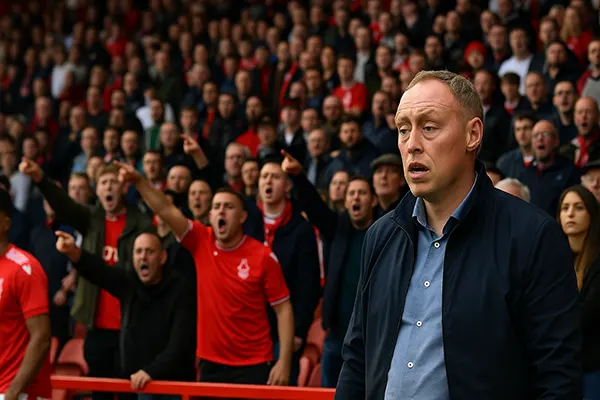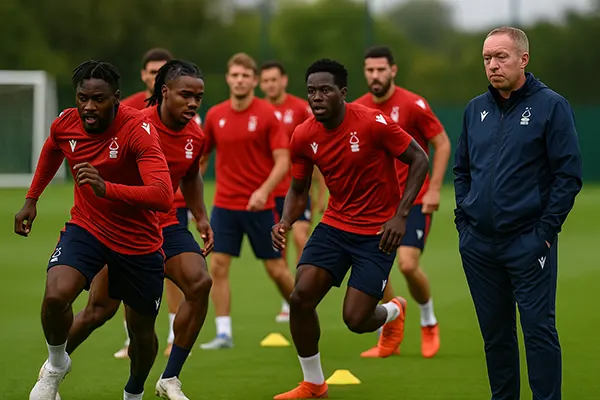Nottingham Forest Under Fire: Why Fans Are Chanting ‘You’re Getting Sacked’ and What Lies Ahead for the Coach

Nottingham Forest are facing one of their toughest periods in recent history. With disappointing results piling up and fans voicing their discontent, the club’s manager finds himself under growing pressure. The chants of “You’re getting sacked” echo through the City Ground, reflecting a wider crisis that extends beyond the pitch. The team’s future, tactical direction, and locker-room morale have all come under scrutiny.
The Recent Downfall and Poor Results
Since the start of the 2024–2025 Premier League season, Nottingham Forest have struggled to find consistency. After a promising start with a narrow victory over Crystal Palace, the club’s form rapidly deteriorated. A string of losses to Brentford, West Ham, and Everton left supporters questioning the team’s preparation and fitness. The 4–0 defeat to Aston Villa in late September was a turning point, marking the beginning of public unrest among fans.
Statistics underline the concern: in their first ten matches, Forest collected just eight points, placing them dangerously close to the relegation zone. Home performances, once the team’s stronghold, have faltered. Players appear short on confidence, with midfield cohesion and defensive stability notably absent in recent matches.
Press conferences have grown tense as journalists question tactical choices and player selections. The manager’s insistence on rotating the squad has raised eyebrows, with critics claiming it prevents players from building chemistry on the field.
Key Tactical Decisions and Squad Issues
The manager’s tactical experiments have drawn criticism from both analysts and fans. Frequent formation changes, from 4-2-3-1 to 3-5-2, have disrupted rhythm and left players confused about their roles. While intended to strengthen defence, these adjustments have often backfired, exposing weaknesses in transition and creating gaps in midfield.
Summer transfers, including the high-profile signing of Portuguese winger João Carvalho and loan of defender Malang Sarr, have yet to deliver the expected impact. Injuries to key figures like Taiwo Awoniyi and Morgan Gibbs-White have further complicated matters, leaving the attack blunt and predictable.
Despite these setbacks, training ground reports suggest the manager remains committed to rebuilding confidence. Insiders describe intense sessions focused on positional play and pressing – signs that he is not ready to give up the fight.
Fan Frustration and Expert Reactions
The growing unrest among supporters has become impossible to ignore. Social media platforms are flooded with calls for a managerial change, with fan forums describing the atmosphere as “toxic” after home defeats. Many lifelong followers feel betrayed by the lack of progress since the club’s Premier League return in 2022.
Football pundits have offered divided opinions. Some, like former Forest captain Chris Cohen, argue that patience is needed: “The club has invested heavily, but stability takes time.” Others, including BBC analyst Garth Crooks, have been less forgiving, suggesting that the manager’s approach “lacks a clear identity.”
The board’s silence adds to the tension. While there have been no official statements about a potential sacking, insiders hint that results in the next three matches could determine the manager’s future. The upcoming fixtures against Wolves, Bournemouth, and Fulham are now seen as decisive.
The Voice of the Fans
At the City Ground, frustration has reached a boiling point. During recent matches, chants of “You’re getting sacked in the morning” have become common, signalling a loss of faith. For many supporters, it’s not just about results but about the perceived lack of identity and effort on the pitch.
Season-ticket holders, who have followed the club through decades of ups and downs, are calling for transparency from management. “We just want clarity and direction,” one fan told local media. “If there’s a plan, we need to see it.”
However, not all voices are hostile. Some fans still back the coach, recalling how he guided Forest through the Championship and secured their top-flight survival. They believe he deserves more time to rebuild after injuries and structural changes.

Impact on Betting and Match Predictions
The ongoing turmoil at Nottingham Forest has not gone unnoticed in the betting market. Analysts note that odds for Forest victories have lengthened across most major sportsbooks. The uncertainty around the manager’s position has led to fluctuating lines, particularly in games against similarly ranked clubs.
Professional bettors caution against ignoring internal instability when placing wagers. A divided locker room or looming managerial change can dramatically affect player performance, motivation, and tactical cohesion. For instance, in recent matches following public protests, Forest conceded an average of 2.3 goals per game – nearly double their early-season rate.
As rumours swirl about potential replacements, from Graham Potter to Steve Cooper’s former assistants, punters are advised to monitor official news closely before making predictions. The club’s morale and future direction may shift rapidly depending on the board’s next decision.
What the Future Holds
Regardless of short-term outcomes, Nottingham Forest face a defining chapter. The next month could determine whether they stabilise or descend into another managerial overhaul. A balance between faith and pragmatism will be crucial for both board and supporters.
If the manager survives the current pressure, he must deliver immediate results and restore tactical discipline. A focus on core players, consistent formations, and renewed trust could spark recovery. Conversely, continued decline may force the board’s hand before the winter transfer window.
Ultimately, the situation reflects the broader challenge of modern football: sustaining long-term vision in an environment of instant judgement. Whether Nottingham Forest rise again or succumb to internal divisions will depend on leadership – both on the pitch and in the boardroom.




